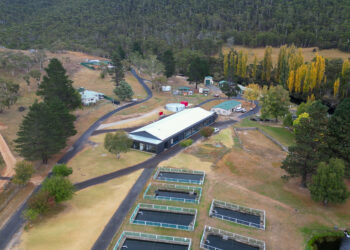THE spot tail bass (lutjanus fuscescens) are a close relative to the more commonly known species, mangrove jack and Papuan black bass. Like jacks and black bass, spot tail are ambush predators, often inhabiting structure and using explosive power and incredibly strong jaws to crunch passing prey.
Spot tail are a striking fish in appearance with gold/green colouration, faint vertical stripes and a large dark spot just before their tail wrist. Like most well known lutjanids or “snappers”, spot tail, have an impressive dental display and require the angler to pay particular attention to the tackle required to catch them – strong line, lures and hooks are advisable!

Spot tail are most commonly encountered in the rivers of Papua New Guinea, usually by anglers chasing the revered black bass. However, spot tail are also quite common in the brackish and freshwater reaches of many small river systems in the Solomon Islands (some of which can also hold black bass). Not a great deal is known about spot tail bass in the Solomons, but it is thought they prefer the fast flowing freshwater reaches and pools found upstream of the tidal flow. Strangely, spot tail bass are very popular in Australia despite them never being encountered in Australian waters. However, the hard fighting nature of spot tail combined with the impressive locations they inhabit is a winning sportfishing recipe – an irresistible temptation for many keen Australian anglers.

I’ve recently returned from my maiden trip to the Solomons, and after catching my first spot tail bass, I’m very keen to visit again. I was fishing the Fufuwana RIver out of Papatura retreat. Not being the first to fish here, I had a fair idea of what to expect, but casting to these big, powerful fish in tight, clear waters surrounded by dense rainforest is an experience undoubtedly hard to convey adequately. Your casting must be on-point and your tackle and reflexes up to scratch to wrestle one of these fish out of heavy cover. I packed light and took a handful of shallow diving jerkbaits and some softplastics as the locals informed me they feed mostly on baitfish (largely mullet), prawns and crabs. I was using the new Abu Garcia MGXtreme baitcaster paired to an Abu Garcia Salty Stage KR-X 4-8kg baitcaster rod. This combo is extremely light (yet packs a punch) and enables you to cast all day with pin point accuracy.

From my experience, every likely looking spot must be peppered with casts at least a few times. My best fish came after upwards of 10 casts casts along the same thick overhanging foliage. Spot tail hit hard and quickly head for cover so a heavy hook set and drag is required to wrestle them out. I was using PE3 on the MGX and running 40lb leader. In hindsight, I would take two outfits, one with 20-30lb leader for a more finesse presentation when sightcasting to the odd fish roaming out in the open and the other outfit with heavier 40-50lb leader to work the snags and log jams. The lighter outfit could also be used to have some fun on the local jungle perch and mangrove jack, which are plentiful.
Trudging for kilometres through the jungle with a bush knife isn’t everyone’s cup of tea, but chasing spot tail bass in the Solomons was an enjoyable experience I won’t forget. The fishing reminded me of skinny water bass/JP fishing back in Australia, but only supercharged! The heat and humidity is intense, the rainforest is unbelievably thick and the fish get big!
For more info, visit visitsolomons.com.sb and papatura.com.
















